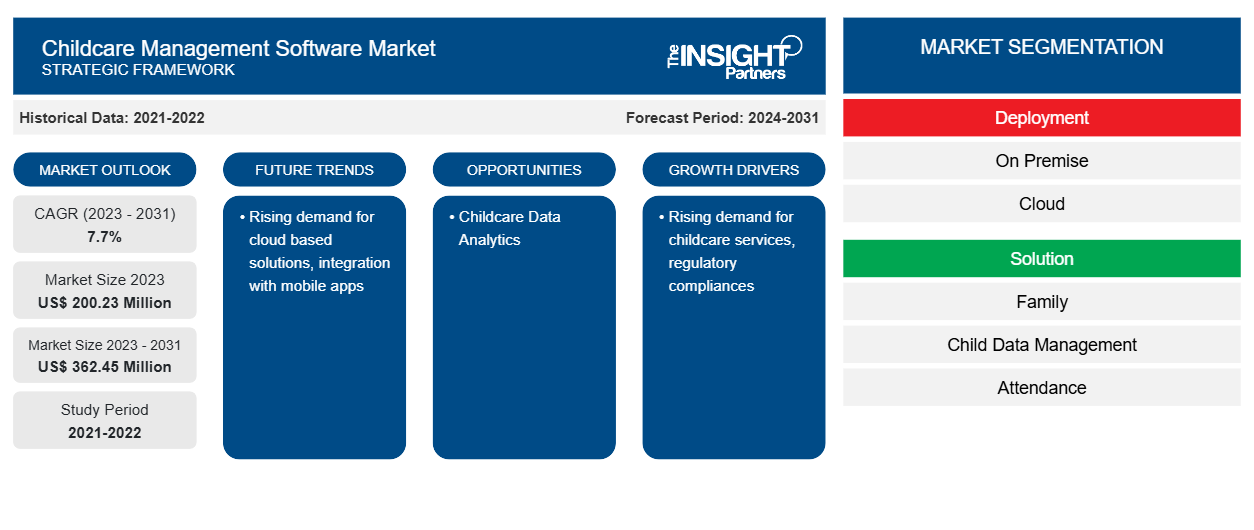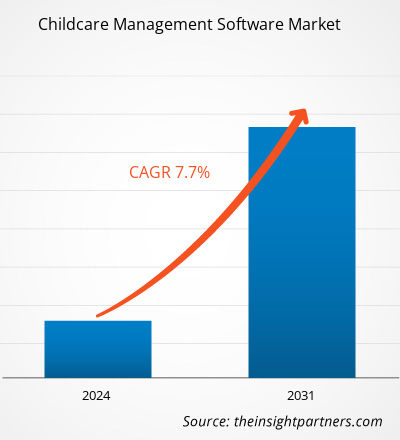Childcare Management Software Market Growth and Forecast by 2031
Historic Data: 2021-2022 | Base Year: 2023 | Forecast Period: 2024-2031Childcare Management Software Market Size and Forecast (2021–2031), Global and Regional Share, Trend, and Growth Opportunity Analysis Report Coverage: By Deployment (On Premise and Cloud), Solution (Family and Child Data Management, Attendance, Accounting, Time and Activity Management, Nutrition Management, and Others), and Application (Daycare, Before and After Care, Pre School, Camps, and Others), and Geography
- Report Date : Mar 2026
- Report Code : TIPRE00007672
- Category : Technology, Media and Telecommunications
- Status : Data Released
- Available Report Formats :


- No. of Pages : 150
The childcare management software market size is projected to reach US$ 362.45 million by 2031 from US$ 200.23 million in 2023. The market is expected to register a CAGR of 7.7% in 2023–2031. Rising demand for cloud-based solutions and integration with mobile apps are likely to remain key Childcare Management Software market trends.
Childcare Management Software Market Analysis
Childcare management software is a form of software used to help daycare and childcare organizations run their operations. After opening a preschool center, it can be utilized for a variety of purposes, including tracking attendance, managing money, and communicating with parents. An efficient and successful childcare business requires smooth organization, effective communication, and streamlined administrative procedures, this is driving the demand for childcare management software market.
Childcare Management Software Market Overview
The global childcare management software demand is driven mainly by the increasing number of parents in the global workforce. This generates the need for more and more childcare institutions across the globe majorly in the metro cities. Moreover, the need for real-time tracking of child activities in these childcare centers is resulting in the adoption of efficient childcare management software by these centers.
Customize This Report To Suit Your Requirement
You will get customization on any report - free of charge - including parts of this report, or country-level analysis, Excel Data pack, as well as avail great offers and discounts for start-ups & universities
Childcare Management Software Market: Strategic Insights

-
Get Top Key Market Trends of this report.This FREE sample will include data analysis, ranging from market trends to estimates and forecasts.
Childcare Management Software Market Drivers and Opportunities
Regulatory Compliances to Favor Market
Compliance is a critical component of operating a successful daycare business. It assures that the children in your care are safe, healthy, and happy and that your employees are properly trained, competent, and professional. Compliance also protects your company from legal ramifications, financial penalties, and reputational harm. However, compliance can be difficult to navigate, particularly in the dynamic and diverse childcare industry. There are numerous regulations, standards, and best practices that you must follow, which may differ depending on your location, service type, and accreditation status. Furthermore, compliance is a continuous process that necessitates regular monitoring, updating, and reporting. Childcare providers must preserve numerous records for their employees, children, and families, including attendance, health, immunization, enrollment, emergency contact, and payment information. These records must be updated on a regular basis and securely stored to ensure data privacy and confidentiality. However, manually maintaining these records can be time-consuming, error-prone, and wasteful. This drives the demand for childcare management software in the market.
Childcare Data Analytics – An Opportunity in Childcare Management Software
Childcare services have a significant impact on the development of our society. These services, which range from early childhood education to safeguarding children's safety and well-being, are critical for both working parent's and young minds' overall development. However, running child care centers efficiently is no easy task. Providers face various obstacles, such as sustaining high-quality care, optimizing resource allocation, and assuring regulatory compliance. This is where data analytics comes in as a valuable tool for uncovering insights and driving good change. Analytics assists in determining the success of educational initiatives. Analytics reveals opportunities for improvement, such as maintaining good cleanliness, avoiding accidents, and responding to health concerns quickly.
Childcare Management Software Market Report Segmentation Analysis
Key segments that contributed to the derivation of the Childcare Management Software market analysis are deployment, solution, and application.
- Based on the deployment, the childcare management software market is divided into on-premise and cloud. The cloud segment held the largest share of the market in 2023.
- Based on the solution, the childcare management software market is divided into family and child data management, attendance, accounting, time and activity management, nutrition management, and others.
- Based on the application, the childcare management software market is divided into daycare, before and after care, preschool, camps, and others.
Childcare Management Software Market Share Analysis by Geography
The geographic scope of the Childcare Management Software market report is mainly divided into five regions: North America, Asia Pacific, Europe, Middle East & Africa, and South America/South & Central America.
North America has dominated the childcare management software market. Technological developments and initiatives taken by the government across North America are driving the growth of the market. The Childcare Management Software market is undergoing substantial development in North America, which can be attributed significant rise in employment in women in the region.
Childcare Management Software Market Regional InsightsThe regional trends and factors influencing the Childcare Management Software Market throughout the forecast period have been thoroughly explained by the analysts at The Insight Partners. This section also discusses Childcare Management Software Market segments and geography across North America, Europe, Asia Pacific, Middle East and Africa, and South and Central America.
Childcare Management Software Market Report Scope
| Report Attribute | Details |
|---|---|
| Market size in 2023 | US$ 200.23 Million |
| Market Size by 2031 | US$ 362.45 Million |
| Global CAGR (2023 - 2031) | 7.7% |
| Historical Data | 2021-2022 |
| Forecast period | 2024-2031 |
| Segments Covered |
By Deployment
|
| Regions and Countries Covered |
North America
|
| Market leaders and key company profiles |
|
Childcare Management Software Market Players Density: Understanding Its Impact on Business Dynamics
The Childcare Management Software Market is growing rapidly, driven by increasing end-user demand due to factors such as evolving consumer preferences, technological advancements, and greater awareness of the product's benefits. As demand rises, businesses are expanding their offerings, innovating to meet consumer needs, and capitalizing on emerging trends, which further fuels market growth.

- Get the Childcare Management Software Market top key players overview
Childcare Management Software Market News and Recent Developments
The Childcare Management Software market is evaluated by gathering qualitative and quantitative data post-post-primary and secondary research, which includes important corporate publications, association data, and databases. The following is a list of developments in the market for Childcare Management Software and strategies:
- Brightwheel, the leading all-in-one early education platform, announced the acquisition of Experience Early Learning, a nationally known brand that develops a comprehensive research-based early education curriculum and evaluation system. Bright Wheel's acquisition brings together the best of physical and digital learning tools for the first time, advancing its aim to provide high-quality early education to all children. (Source: Brightwheel, Press Release, 2023)
Childcare Management Software Market Report Coverage and Deliverables
The “Childcare Management Software Market Size and Forecast (2023–2031)” report provides a detailed analysis of the market covering below areas:
- Market size and forecast at global, regional, and country levels for all the key market segments covered under the scope
- Market dynamics such as drivers, restraints, and key opportunities
- Key future trends
- Detailed PEST/Porter’s Five Forces and SWOT analysis
- Global and regional market analysis covering key market trends, major players, regulations, and recent market developments
- Industry landscape and competition analysis covering market concentration, heat map analysis, prominent players, and recent developments
- Detailed company profiles
Frequently Asked Questions
What is the estimated market size for the global Childcare Management Software market in 2023?
What are the driving factors impacting the global Childcare Management Software market?
What are the future trends of the global Childcare Management Software market?
Which deployment segment held the major share in 2023?
Which are the key players holding the major market share of the global Childcare Management Software market?
Ankita is a dynamic market research and consulting professional with over 8 years of experience across the technology, media, ICT, and electronics & semiconductor sectors. She has successfully led and delivered 100+ consulting and research assignments for global clients such as Microsoft, Oracle, NEC Corporation, SAP, KPMG, and Expeditors International. Her core competencies include market assessment, data analysis, forecasting, strategy formulation, competitive intelligence, and report writing.
Ankita is adept at handling complete project cycles—from pre-sales proposal design and client discussions to post-sales delivery of actionable insights. She is skilled in managing cross-functional teams, structuring complex research modules, and aligning solutions with client-specific business goals. Her excellent communication, leadership, and presentation abilities have enabled her to consistently deliver value-driven outcomes in fast-paced and evolving market environments.
- Historical Analysis (2 Years), Base Year, Forecast (7 Years) with CAGR
- PEST and SWOT Analysis
- Market Size Value / Volume - Global, Regional, Country
- Industry and Competitive Landscape
- Excel Dataset
Recent Reports
Related Reports
Testimonials
The Insight Partners' SCADA System Market report is comprehensive, with valuable insights on current trends and future forecasts. The team was highly professional, responsive, and supportive throughout. We are very satisfied and highly recommend their services.
RAN KEDEM Partner, Reali Technologies LTDsI requested a report on a very specific software market and the team produced the report in a few days. The information was very relevant and well presented. I then requested some changes and additions to the report. The team was again very responsive and I got the final report in less than a week.
JEAN-HERVE JENN Chairman, Future AnalyticaWe worked with The Insight Partners for an important market study and forecast. They gave us clear insights into opportunities and risks, which helped shape our plans. Their research was easy to use and based on solid data. It helped us make smart, confident decisions. We highly recommend them.
PIYUSH NAGPAL Sr. Vice President, High Beam GlobalThe Insight Partners delivered insightful, well-structured market research with strong domain expertise. Their team was professional and responsive throughout. The user-friendly website made accessing industry reports seamless. We highly recommend them for reliable, high-quality research services
YUKIHIKO ADACHI CEO, Deep Blue, LLC.This is the first time I have purchased a market report from The Insight Partners.While I was unsure at first, I visited their web site and felt more comfortable to take the risk and purchase a market report.I am completely satisfied with the quality of the report and customer service. I had several questions and comments with the initial report, but after a couple of dialogs over email with their analyst I believe I have a report that I can use as input to our strategic planning process.Thank you so much for taking the extra time and making this a positive experience.I will definitely recommend your service to others and you will be my first call when we need further market data.
JOHN SUZUKI President and Chief Executive Officer, Board Director, BK TechnologiesI wish to appreciate your support and the professionalism you displayed in the course of attending to my request for information regarding to infectious disease IVD market in Nigeria. I appreciate your patience, your guidance, and the fact that you were willing to offer a discount, which eventually made it possible for us to close a deal. I look forward to engaging The Insight Partners in the future, all thanks to the impression you have created in me as a result of this first encounter.
DR CHIJIOKE ONYIA MANAGING DIRECTOR, PineCrest Healthcare Ltd.Reason to Buy
- Informed Decision-Making
- Understanding Market Dynamics
- Competitive Analysis
- Identifying Emerging Markets
- Customer Insights
- Market Forecasts
- Risk Mitigation
- Boosting Operational Efficiency
- Strategic Planning
- Investment Justification
- Tracking Industry Innovations
- Aligning with Regulatory Trends




















 Get Free Sample For
Get Free Sample For